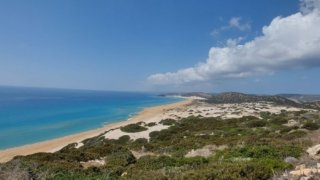Karpas

The Karpas Peninsula (Greek: Καρπασία) is a long, pointed peninsula extending from the northeastern tip of the island of Cyprus. It is de facto under the control of the Turkish Republic of Northern Cyprus.
It starts from the northeastern border of the Mesarya Plain and continues until Cape Zafer. With an area of 817 km², it covers the borders of the Iskele district of Northern Cyprus[1].
The Karpaz Peninsula stretches from the main mass of the Island of Cyprus by thinning in the NE direction. It has a width of about 10-15 km and a length of 80 km. In the administrative area of the Iskele district, which is built on the peninsula, there are İskele, Yenierenköy, and Mehmetçik Subdistricts[1].
It is one of the important regions of Cyprus with its historical and natural appearance. An area around Dipkarpaz of the Karpaz Peninsula, which has a small population compared to its area, is under protection because it has the status of a national park.
Throughout history, the Karpaz Peninsula has been a frequent destination for those who want to escape from civilization or retreat. For this reason, many monasteries were built on the peninsula. The most famous of these monasteries is the Apostolos Andreas Monastery.
The Karpaz Peninsula contains many ancient cities, monasteries and traces of various civilizations. The ancient city of Karpasia is located on the peninsula. This city is located between Dipkarpaz and the rocky coves 5 km north of this point.
In the south of the Karpaz peninsula, about 15 km from the village of Dipkarpaz, there are "Golden Sand" beaches. It consists of two beaches. The total length of the beaches is approximately 3700 m. It is one of the most beautiful beaches of Cyprus in terms of natural beauty and dunes. The golden sand beaches are the breeding grounds for sea turtles such as Caretta caretta and Chelonia mydas.
Tourism activities are intense in the Bosphorus, Yenierenköy and Bafra regions.
The livelihood of the people of the region is mainly agriculture and animal husbandry, and new construction did not occur much until the tourism development that started in the 1990s. In this context, old and traditional buildings are also used in daily life. Traditional Karpaz houses are located in a courtyard surrounded by a garden wall. Places such as toilets and baths are traditionally placed at the end of the courtyard. In general, the houses are single-storey and the living area used for sleeping consists of a large room with an arch. The kitchen can be adjacent to or separate from this room, and there are also places such as animal shelter and warehouse in the courtyard. However, people with high social status also have two-storey houses called "hanay". The use of arches on the exterior comes to the fore, there are windows to ensure air circulation due to climatic conditions, and there is often a skylight. The building material is generally mud brick, and a small number of yellow stones are also observed in the building, and the top of the wall is plastered with plaster. Rafter, wicker, reed and earth are used on the roof.
News Date: 12-2021
 Türkçe
Türkçe  English
English 